材料腐蚀与防护(英语)
- 格式:pptx
- 大小:1.60 MB
- 文档页数:14
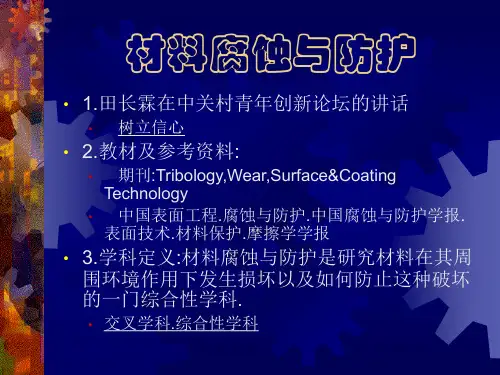
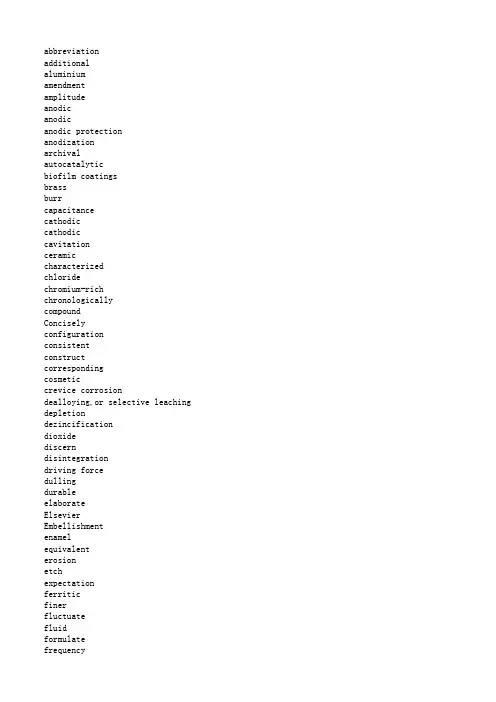
abbreviationadditionalaluminiumamendmentamplitudeanodicanodicanodic protectionanodizationarchivalautocatalyticbiofilm coatingsbrassburrcapacitancecathodiccathodiccavitationceramiccharacterizedchloridechromium-richchronologicallycompoundConciselyconfigurationconsistentconstructcorrespondingcosmeticcrevice corrosiondealloying,or selective leaching depletiondezincificationdioxidediscerndisintegrationdriving forcedullingdurableelaborateElsevierEmbellishmentenamelequivalenterosionetchexpectationferriticfinerfluctuatefluidformulatefrequencyfuel pipelinesFundamentalgalvanicgalvanic,or two-metal corrosion galvanostaticgenerategraphitizationhematitehigh silicon cast ironhydrogen embrittlementhypothesesillustrateimmenselyimpedanceimpressed current cathodic protection impuritiesindexinfiniteinhibitor缩写;缩写词附加的,额外的铝合金修正案;改善;改正振幅;幅度;波幅;广阔,充足阳极平行;adj平行的;类似的,相同的阳极的;稳定态阳极保护阳极化,阳极处理档案的自催化生物膜涂层黄铜;黄铜制品毛刺:毛边电容;电容量;容量;电容值阴极保护阴极气蚀:空穴现象陶瓷以。

材料腐蚀与防护英文介绍范文English: Material corrosion occurs when a material deteriorates as a result of a chemical or electrochemical reaction with its environment. This can lead to structural weakening, reduced functionality, and even system failure. To prevent material corrosion, various protection methods can be employed including the use of coatings, inhibitors, cathodic protection, and material selection. Coatings act as a barrier between the material and its environment, inhibiting the corrosive agents from reaching the surface. Inhibitors are chemicals that can be applied to the material's surface to reduce the rate of corrosion. Cathodic protection involves making the material the cathode in a galvanic cell, which prevents corrosion from occurring. Material selection is also crucial in preventing corrosion, as choosing a material that is resistant to the corrosive environment can significantly reduce the risk of degradation. Overall, understanding the mechanisms of material corrosion and implementing appropriate protection methods is essential in maintaining the integrity and longevity of various structures and systems.中文翻译: 材料腐蚀是指材料由于与环境发生化学或电化学反应而导致的恶化过程。
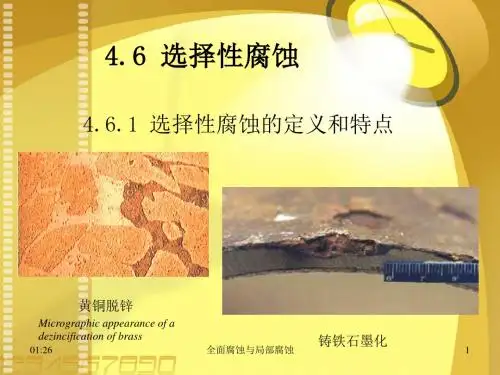
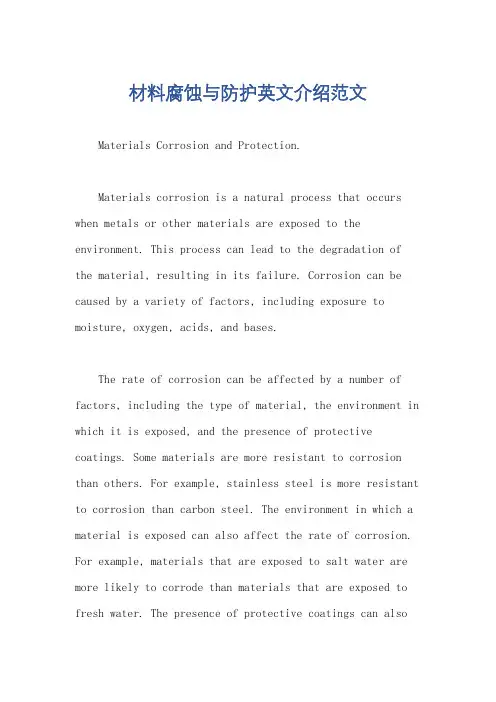
材料腐蚀与防护英文介绍范文Materials Corrosion and Protection.Materials corrosion is a natural process that occurs when metals or other materials are exposed to the environment. This process can lead to the degradation of the material, resulting in its failure. Corrosion can be caused by a variety of factors, including exposure to moisture, oxygen, acids, and bases.The rate of corrosion can be affected by a number of factors, including the type of material, the environment in which it is exposed, and the presence of protective coatings. Some materials are more resistant to corrosion than others. For example, stainless steel is more resistant to corrosion than carbon steel. The environment in which a material is exposed can also affect the rate of corrosion. For example, materials that are exposed to salt water are more likely to corrode than materials that are exposed to fresh water. The presence of protective coatings can alsoslow down the rate of corrosion. These coatings can act as a barrier between the material and the environment, preventing the material from coming into contact with the corrosive agents.Corrosion can have a significant impact on the performance and lifespan of materials. For example, corrosion can lead to the failure of metal components in bridges, buildings, and other structures. It can also lead to the failure of pipes, tanks, and other vessels that are used to store or transport fluids.There are a number of methods that can be used to protect materials from corrosion. These methods include:Using corrosion-resistant materials: Some materials are more resistant to corrosion than others. For example, stainless steel is more resistant to corrosion than carbon steel.Applying protective coatings: Protective coatings can act as a barrier between the material and the environment,preventing the material from coming into contact with the corrosive agents.Using cathodic protection: Cathodic protection is a process that uses an external electrical current to protect a metal from corrosion.Using sacrificial anodes: Sacrificial anodes are made of a metal that is more reactive than the metal that is being protected. The sacrificial anode corrodes instead of the protected metal.The best method of corrosion protection will depend on the specific application. It is important to consider the type of material, the environment in which it will be exposed, and the desired level of protection.Corrosion and the Environment.The environment can have a significant impact on the rate of corrosion. Some environments are more corrosive than others. For example, materials that are exposed tosalt water are more likely to corrode than materials that are exposed to fresh water. The presence of pollutants in the environment can also increase the rate of corrosion.The following are some of the factors that can affect the corrosiveness of the environment:Temperature: The rate of corrosion generally increases with increasing temperature.Humidity: The rate of corrosion generally increases with increasing humidity.Salinity: The rate of corrosion generally increases with increasing salinity.Acidity: The rate of corrosion generally increases with increasing acidity.Pollutants: The presence of pollutants in the environment can increase the rate of corrosion.Corrosion Protection.There are a number of methods that can be used to protect materials from corrosion. These methods include:Using corrosion-resistant materials: Some materials are more resistant to corrosion than others. For example, stainless steel is more resistant to corrosion than carbon steel.Applying protective coatings: Protective coatings can act as a barrier between the material and the environment, preventing the material from coming into contact with the corrosive agents.Using cathodic protection: Cathodic protection is a process that uses an external electrical current to protect a metal from corrosion.Using sacrificial anodes: Sacrificial anodes are made of a metal that is more reactive than the metal that is being protected. The sacrificial anode corrodes instead ofthe protected metal.The best method of corrosion protection will depend on the specific application. It is important to consider the type of material, the environment in which it will be exposed, and the desired level of protection.Conclusion.Corrosion is a natural process that can have a significant impact on the performance and lifespan of materials. However, there are a number of methods that can be used to protect materials from corrosion. By understanding the factors that affect corrosion, and by using the appropriate protective measures, it is possible to extend the life of materials and reduce the risk of failure.。
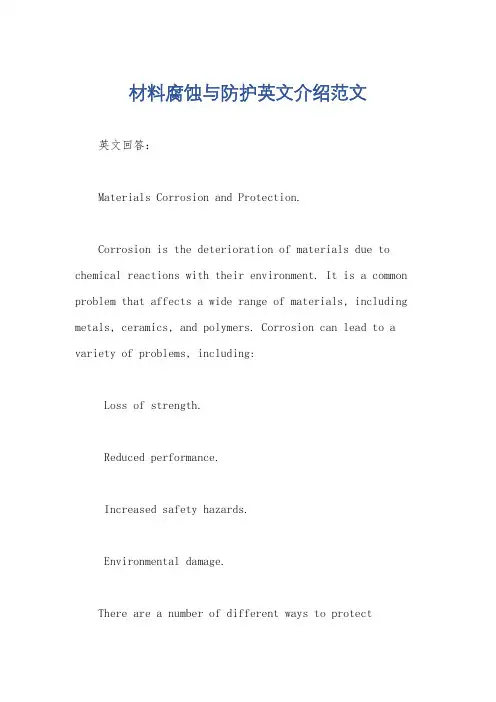
材料腐蚀与防护英文介绍范文英文回答:Materials Corrosion and Protection.Corrosion is the deterioration of materials due to chemical reactions with their environment. It is a common problem that affects a wide range of materials, including metals, ceramics, and polymers. Corrosion can lead to a variety of problems, including:Loss of strength.Reduced performance.Increased safety hazards.Environmental damage.There are a number of different ways to protectmaterials from corrosion, including:Using corrosion-resistant materials.Applying protective coatings.Using cathodic protection.Using sacrificial anodes.The best method of corrosion protection depends on the specific material and environment involved.Materials:The type of material used is a major factor in determining its susceptibility to corrosion. Some materials, such as stainless steel and aluminum, are naturallyresistant to corrosion. Other materials, such as iron and steel, are more susceptible to corrosion.Environment:The environment in which a material is used also playsa role in its susceptibility to corrosion. Factors such as temperature, humidity, and the presence of corrosive chemicals can all affect the rate of corrosion.Protective Coatings:Protective coatings can be applied to materials to protect them from corrosion. These coatings can be made ofa variety of materials, including paint, plastic, and metal. Protective coatings can provide a barrier between the material and the corrosive environment, and they can also help to slow down the rate of corrosion.Cathodic Protection:Cathodic protection is a technique that is used to protect metals from corrosion. This technique involves connecting the metal to a more reactive metal, which actsas a sacrificial anode. The sacrificial anode corrodes instead of the metal, thereby protecting it from damage.Sacrificial Anodes:Sacrificial anodes are used to protect metals from corrosion. These anodes are made of a more reactive metal than the metal that they are protecting. The sacrificial anode corrodes instead of the metal, thereby protecting it from damage.中文回答:材料腐蚀与防护。
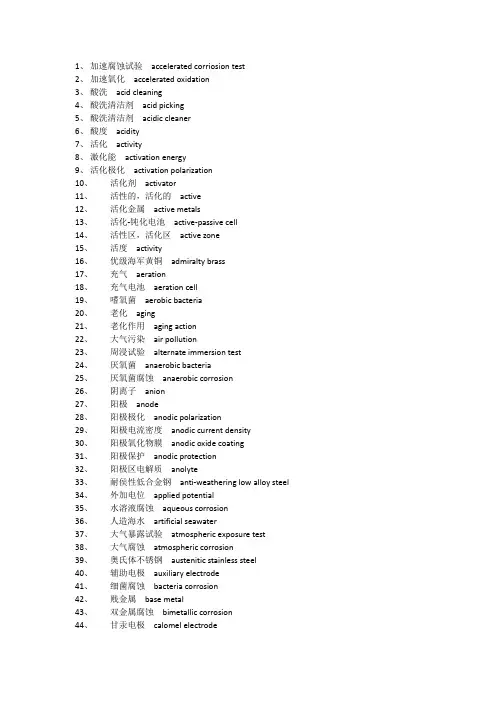
1、加速腐蚀试验accelerated corriosion test2、加速氧化accelerated oxidation3、酸洗acid cleaning4、酸洗清洁剂acid picking5、酸洗清洁剂acidic cleaner6、酸度acidity7、活化activity8、激化能activation energy9、活化极化activation polarization10、活化剂activator11、活性的,活化的active12、活化金属active metals13、活化-钝化电池active-passive cell14、活性区,活化区active zone15、活度activity16、优级海军黄铜admiralty brass17、充气aeration18、充气电池aeration cell19、嗜氧菌aerobic bacteria20、老化aging21、老化作用aging action22、大气污染air pollution23、周浸试验alternate immersion test24、厌氧菌anaerobic bacteria25、厌氧菌腐蚀anaerobic corrosion26、阴离子anion27、阳极anode28、阳极极化anodic polarization29、阳极电流密度anodic current density30、阳极氧化物膜anodic oxide coating31、阳极保护anodic protection32、阳极区电解质anolyte33、耐侯性低合金钢anti-weathering low alloy steel34、外加电位applied potential35、水溶液腐蚀aqueous corrosion36、人造海水artificial seawater37、大气暴露试验atmospheric exposure test38、大气腐蚀atmospheric corrosion39、奥氏体不锈钢austenitic stainless steel40、辅助电极auxiliary electrode41、细菌腐蚀bacteria corrosion42、贱金属base metal43、双金属腐蚀bimetallic corrosion44、甘汞电极calomel electrode45、甘汞电极电位calomel electrode potential46、碳化carburizing47、阴极cathode48、阴极保护cathodic protection49、阴极极化cathodic polarization50、阴极电流密度cathodic current density51、阴极电流效率cathodic current efficiency52、阴极区电解质catholyte53、阳离子cation54、碱脆caustic embrittlement55、空泡作用cavitation56、空泡腐蚀cavitation corrosion57、空泡损伤cavitation damage58、空泡磨蚀cavitation erosion59、电池cell60、渗镀,渗碳cementation61、化学清洗chemical cleaning62、化学转化涂层chemical conversion coating63、化学钝化chemical passivation64、化学镀chemical〔electroless〕plating65、铬酸盐处理〔铬化〕chromating66、清洗液cleaning solution67、浓差电池concentration cell68、接触腐蚀contact corrosion69、转换涂层conversion coating70、恒变形constant deflection71、恒载荷constant load72、腐蚀corrosion73、腐蚀-磨蚀corrosion-erosion74、腐蚀疲劳corrosion fatigue75、腐蚀电位corrosion potential76、腐蚀控制corrosion control77、腐蚀电流corrosion current78、腐蚀电流密度corrosion current density79、腐蚀疲劳开裂corrosion fatigue cracking80、腐蚀疲劳极限corrosion fatigue limit81、腐蚀产物corrosion product82、腐蚀速率corrosion rate83、腐蚀科学corrosion science84、腐蚀试验corrosion test85、腐蚀失重corrosion weight loss86、腐蚀增重corrosion weight gain87、电偶couple88、电偶作用couple action89、开裂cracking90、龟裂crazing91、缝隙腐蚀crevice corrosion92、临界阳极电流密度critical anodic current density93、临界浓度critical concentration94、临界湿度critical humidity95、晶体crystal96、辅助电极counter electrode97、电流密度current density98、去活化作用deactivation99、脱合金元素作用dealloying100、脱铝dealuminization101、去气deaeration102、缺陷defect103、脱脂degreasing104、去矿化物质demineralization105、去极化depolarization106、腐蚀深度depth of corrosion107、沉积物腐蚀deposit corrosion108、脱锌dezincification109、扩散diffusion110、扩散电位diffusion potential111、差异充气电池differential aeration cell112、极限扩散电流密度diffusion limited current density 113、电流electric current114、电位electric potential115、电化学电池electrochemical cell116、电化学腐蚀electrochemical corrosion117、电化学当量electrochemical equivalent118、电极electrode119、电极电位electrode potential120、电极反应electrode reaction121、电解质electrolyte122、电解electrolysis123、电解清洗electrolytic cleaning124、电动序electromotive force〔Emf〕series125、负电性电位electropositive potential126、电泳沉积electrophoretic deposition127、电镀electroplating128、正电性电位electropositive potential129、静电喷涂层electrostatic coating130、脆化embrittlement131、磨耗erosion132、磨耗腐蚀〔或冲击腐蚀〕erosion-corrosion133、平衡电位equilibrium potential134、腐蚀极化图Evans diagram135、剥蚀exfoliation corrosion136、交换电流密度exchange current density 137、暴露实验exposure test138、疲劳fatigue139、铁素体ferrite140、铁素体不锈钢ferrite stainless steel 141、丝状腐蚀filiform corrosion142、弗拉德电位Flade potential143、剥层腐蚀foliation144、膜film145、微动腐蚀fretting corrosion146、燃灰腐蚀fuel ash corrosion147、电偶作用galvanic action148、伽法尼电池galvanic cell149、电偶腐蚀galvanic corrosion150、电偶对galvanic couple151、电偶序galvanic series152、热镀锌galvanizing153、恒电流的galvanoststatic154、普遍〔全面〕腐蚀general corrosion 155、晶界裂纹grain boundary crack156、晶粒grain157、石墨化腐蚀graphitic corrosion158、重量法gravimetric methods159、绿锈green rot160、哈氏合金hastelloy161、热影响区heat affected zone〔HAZ〕162、耐热钢heat resistant steel163、热处理heat treatment164、高温腐蚀high temperature corrosion 165、热腐蚀hot corrosion166、热镀铝hot-dip alumizing167、湿度humidity168、氢腐蚀hydrogen attack169、氢鼓泡hydrogen blistering170、氢损伤hydrogen damage171、氢电极hydrogen electrode172、氢脆hydrogen embrittlement173、氢致开裂hydrogen induced cracking 174、氢超电压hydrogen overvoltage175、氢标hydrogen scale176、浸泡实验immersion test177、冲蚀impingement corrosion178、因科乃尔Inconel179、因科罗Incoloy180、工业大气industrial atmosphere181、缓蚀剂inhibitor182、晶间裂纹intergranular crack183、不溶性阳极insoluble anode184、晶间腐蚀intergranular corrosion185、延晶应力腐蚀断裂intergranular stress corrosion cracking 186、内氧化interal oxidation187、内应力interal stress188、例子浓差电池ion concentration cell189、离子ion190、离子注入ion implantation191、刀线腐蚀knife-line corrosion192、激光釉化laser glazing193、层状腐蚀layer corrosion194、晶格缺陷lattic defect195、液态金属腐蚀liquid metal corrosion196、局部作用local action197、局部电池local cell198、局部腐蚀local corrosion199、海洋腐蚀marine corrosion200、马氏体martensite201、马氏体不锈钢martensitic stainless steel202、力学性能mechanical property203、金属离子浓差电池metal ion concentration cell204、金属喷镀metal spray205、金属镀层metallic coating206、微生物腐蚀microbiological corrosion207、金属粉化metal dusting208、混合电位mixed potential209、轧制铁鳞mill scale210、贵金属noble metal211、海军黄铜navy brass212、贵电位noble potential213、非金属涂层nonmetallic coating214、氮化nitriding215、过电位overpotential216、氧化oxidation217、开路电位open circuit potential218、氧化-复原电位oxidation-reduction potential219、氧化物oxide220、氧化膜oxide film221、氧浓差电池oxygen concentration cell222、钝化passivation223、钝化剂passivator224、钝化-活化电池passive-active cell225、钝化的,钝性的passive226、铜绿patina227、酸度计pH indicator,acidometer228、磷酸盐处理phosphating229、酸洗液pickling solution230、蚀孔pit231、点蚀pitting232、点蚀击穿电位pitting breakdown potential233、点蚀系数pitting factor234、点蚀电位pitting potential235、极化polarization236、动电位potential dynamic〔potentiokinetic〕237、恒电位仪potentiostat238、恒电位potentisostic239、电位-pH图Pourbaix diagram,potential-pH diagram 240、底涂层prime coat241、保护电位protective potential242、氧化-复原电位redox potential243、复原reduction244、参比电极reference electrode245、相对湿度relative humidity246、残余内应力residua interal stress247、铁锈rust248、防锈油rust preventive oil249、牺牲阳极保护sacrifice anode protection250、盐水喷雾试验salt spray test251、喷砂sand blasting252、饱和甘汞电极saturated calomel electrode〔SCE〕253、氧化皮scale254、季裂season cracking255、选择性腐蚀selective corrosion256、选择性氧化selective oxidation257、自钝化self passivation258、敏化热处理sensitizing heat treatment259、喷丸shot peening260、银-氯化银电极silver-sliver chloride electrode 261、慢应变速率slow strain rate262、土壤腐蚀soil corrosion263、剥离spalling264、不锈钢stainless steel265、标准电极电位standard electrode potential266、标准氢电极standard hydrogen electrode267、应变能strain energy268、杂散电流腐蚀stray current corrosion269、应力场强度因子stress intensity factor270、应力腐蚀断裂stress corrosion cracking〔SCC〕271、硫化sulfidation272、外表氧化surface oxidation273、外表处理surface treatment274、皮下腐蚀subsurface corrosion275、塔菲尔斜率Tafel slope276、失泽tarnish277、抗拉强度tensile strength278、热偶腐蚀thermogalvanic corrosion279、热力学thermodynamics280、结瘤腐蚀tuberculation281、穿晶腐蚀transgranular corrosion282、穿晶应力腐蚀断裂transgranular stress corrosion cracking 283、过钝化transpassive284、膜下腐蚀underfilm corrosion285、均匀腐蚀umiform corrosion286、水线腐蚀waterline corrosion287、焊接腐蚀weld decay288、湿度humidity289、工作电极working electrode290、291、292、。
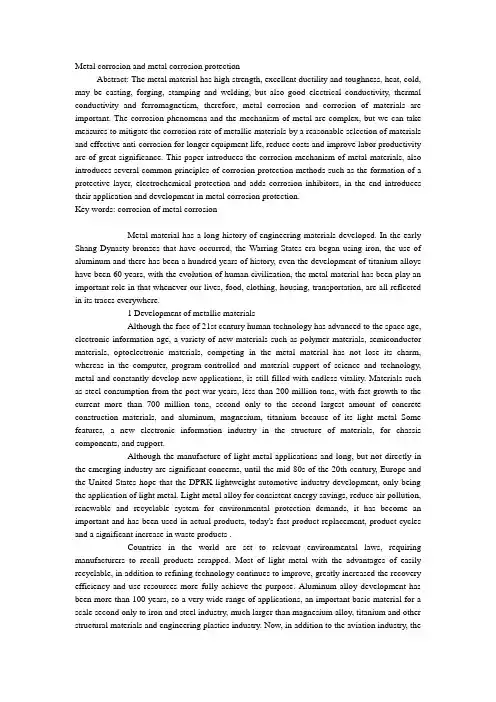
Metal corrosion and metal corrosion protectionAbstract: The metal material has high strength, excellent ductility and toughness, heat, cold, may be casting, forging, stamping and welding, but also good electrical conductivity, thermal conductivity and ferromagnetism, therefore, metal corrosion and corrosion of materials are important. The corrosion phenomena and the mechanism of metal are complex, but we can take measures to mitigate the corrosion rate of metallic materials by a reasonable selection of materials and effective anti-corrosion for longer equipment life, reduce costs and improve labor productivity are of great significance. This paper introduces the corrosion mechanism of metal materials, also introduces several common principles of corrosion protection methods such as the formation of a protective layer, electrochemical protection and adds corrosion inhibitors, in the end introduces their application and development in metal corrosion protection.Key words: corrosion of metal corrosionMetal material has a long history of engineering materials developed. In the early Shang Dynasty bronzes that have occurred, the Warring States era began using iron, the use of aluminum and there has been a hundred years of history, even the development of titanium alloys have been 60 years, with the evolution of human civilization, the metal material has been play an important role in that whenever our lives, food, clothing, housing, transportation, are all reflected in its traces everywhere.1 Development of metallic materialsAlthough the face of 21st century human technology has advanced to the space age, electronic information age, a variety of new materials such as polymer materials, semiconductor materials, optoelectronic materials, competing in the metal material has not lose its charm, whereas in the computer, program-controlled and material support of science and technology, metal and constantly develop new applications, is still filled with endless vitality. Materials such as steel consumption from the post-war years, less than 200 million tons, with fast growth to the current more than 700 million tons, second only to the second largest amount of concrete construction materials, and aluminum, magnesium, titanium because of its light metal Some features, a new electronic information industry in the structure of materials, for chassis components, and support.Although the manufacture of light metal applications and long, but not directly in the emerging industry are significant concerns, until the mid-80s of the 20th century, Europe and the United States hope that the DPRK lightweight automotive industry development, only being the application of light metal. Light metal alloy for consistent energy savings, reduce air pollution, renewable and recyclable system for environmental protection demands, it has become an important and has been used in actual products, today's fast product replacement, product cycles and a significant increase in waste products .Countries in the world are set to relevant environmental laws, requiring manufacturers to recall products scrapped. Most of light metal with the advantages of easily recyclable, in addition to refining technology continues to improve, greatly increased the recovery efficiency and use resources more fully achieve the purpose. Aluminum alloy development has been more than 100 years, so a very wide range of applications, an important basic material for a scale second only to iron and steel industry, much larger than magnesium alloy, titanium and other structural materials and engineering plastics industry. Now, in addition to the aviation industry, thedaily necessities, there are many applications aluminum products, such as aluminum doors and windows, bicycle rack or aluminum foil package is. Notebook manufacturers have introduced aluminum shell of the notebook, but it is lightweight transport industry as striving States goal.2, the corrosion of metal materialsCorrosion of metallic materials, is the metal contact material and the surrounding medium a chemical or electrochemical action resulting from a destructive phenomenon. As the corrosion of metallic materials can cause equipment to run, run, drip, leak, polluting the environment, and even poisoning, fires, explosions and bad accidents and serious waste of resources and energy. Therefore, the corrosion mechanism of metal materials and understand the causes of corrosion occurs and take effective protective measures, for longer equipment life, reduce costs and improve labor productivity are of great significance.2.1 Classification of metal corrosionIn accordance with the mechanism of metal corrosion can be divided into chemical corrosion of metal corrosion and electrochemical corrosion two categories. Either chemical etching or electrochemical corrosion, the essence of metal corrosion is a process that metal atoms are oxidized to the metal cation.2.2 The mechanism of metal corrosion2.2.1 Chemical etchingMetals and chemical corrosion is a chemical effect of non-electrolyte direct damage caused by the corrosion process is a pure oxidation and reduction of the pure chemical reaction, that is corrosive metal surface atoms directly interact with the formation of corrosion products. Reaction process is not currents, consistent with the chemical kinetics of the process.2.2.2 Electrochemical CorrosionElectrochemical corrosion of metal and the electrolyte solution caused by a chemical role in the destruction. Anode reaction at the same time there is loss of electronic access to electronic and electronic cathode flow, the process to obey the basic laws of electrochemistry. Electrochemical corrosion and, in its different acidity of electrolyte solution into hydrogen corrosion and hydrogen corrosion.3, the main corrosion of metal materials measure3.1 improve the nature of metalDepending on the composition of different materials used corrosion resistant alloys, or metal alloy elements added to improve corrosion resistance, can prevent or slow down the corrosion of metals. For example, in steel containing nickel made of stainless steel can enhance the anti-corrosion.3.2 forms a protective layerMetal surface covered in a variety of protective layer, the corrosion of the protected nature of metal separated by air is an effective way to prevent metal corrosion. Industrial hole secondary layer of protection to use a non-metallic coating and the metal protective layer two categories, usually form a protective layer of the following methods:1) metal phosphate treatment: Iron and steel products to oil, rust, into a specific form of the phosphate solution, soaking the metal surface can form a thin film of water-insoluble phosphate, this process is called phosphate treatment. Phosphate film was dark gray to dark gray, the thickness of 5 to 20 microns, in the atmosphere has good corrosion resistance. Membrane isthe micro porous structure of the painting's absorption capacity, such as bottom paint, corrosion resistance can be further improved.2) Oxidation of metals: Iron and steel products will be added to Na0H and NaN02, the mixed solution, heat treatment, the surface can form a layer thickness of about 0.51.5 micron blue oxide film (the main component Fe3O4), in order to achieve the purpose of corrosion of steel, this process is known as bluing treatment, short hair blue. This oxide film has greater flexibility and lubrication, does not affect the part accuracy. Therefore, precision instruments and optical equipment parts, spring steel, thin steel sheet, steel wire and other common hair blue handle.3) Non-metallic coatings: Metal surface with a plastic coating than paint a better effect. Dense layer of smooth plastic cover. Beautiful color, both the dual function of corrosion and decoration. Enamel is with SiO2 glass with high enamel, with excellent corrosion resistance, and as corrosion-resistant metallic coatings, widely used in petrochemical, pharmaceutical, equipment and other industrial sectors and the daily necessities of.4) The metal protection layer: This is a metal-plated another in the protected metal surface protective coating is formed, called the former metal plating metal. The formation of metal coatings, in addition to electroplating, electro less plating, there are hot dip, hot spraying, diffusion coating, vacuum plating and other methods.3.3 electrochemical protectionsElectrochemical protection is an important measure for metal corrosion protection, its principle is to use an external current to cause the potential of the corrosion metal changes slowly or inhibit metal corrosion. Electrochemical protection can be divided into two methods includes anodic protection and cathodic protection. Anodic protection is to pass enough anode current into the surface of corrosion metal, then the anodic polarization occurs, that is the potential becomes positive and the metal is in a passive state, the metal dissolution greatly slowed. Cathodic protection is to pass enough cathode current into the surface of corrosion metal, the metal cathode polarization occurs, that is the potential becomes negative to prevent metal dissolution.3.4 add corrosion inhibitorsAdd corrosion inhibitor is a commonly used anti-corrosion measure, in a corrosive environment, a small amount of corrosion inhibitor can have physical and chemical effects at the surface of metal which can significantly reducing the corrosion of metallic materials. Since corrosion inhibitor do not need specialized equipment or change the nature of the metal components during use, which are economic, adaptability. So it’s widely used in pickling cooling water systems, oil field water, metal products, transportation and other industrial processes .。
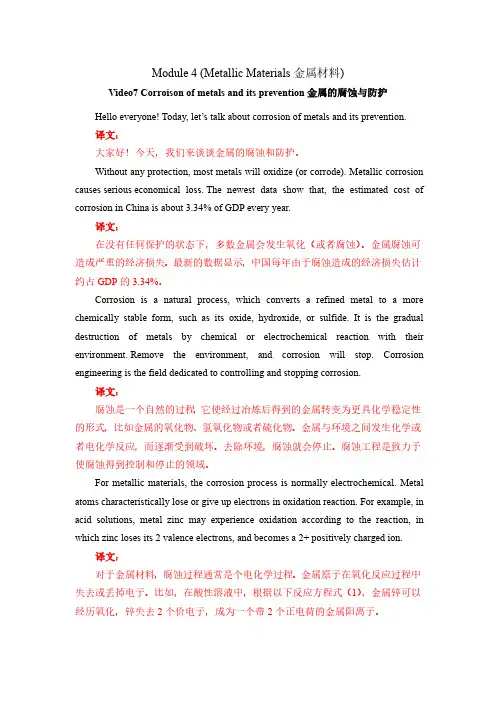
Module 4 (Metallic Materials金属材料)Video7 Corroison of metals and its prevention金属的腐蚀与防护Hello everyone! Today, let’s talk about corrosion of metals and its prevention.译文:大家好!今天,我们来谈谈金属的腐蚀和防护。
Without any protection, most metals will oxidize (or corrode). Metallic corrosion causes serious economical loss. The newest data show that, the estimated cost of corrosion in China is about 3.34% of GDP every year.译文:在没有任何保护的状态下,多数金属会发生氧化(或者腐蚀)。
金属腐蚀可造成严重的经济损失。
最新的数据显示,中国每年由于腐蚀造成的经济损失估计约占GDP的3.34%。
Corrosion is a natural process, which converts a refined metal to a more chemically stable form, such as its oxide, hydroxide, or sulfide. It is the gradual destruction of metals by chemical or electrochemical reaction with their environment. Remove the environment, and corrosion will stop. Corrosion engineering is the field dedicated to controlling and stopping corrosion.译文:腐蚀是一个自然的过程,它使经过冶炼后得到的金属转变为更具化学稳定性的形式,比如金属的氧化物、氢氧化物或者硫化物。

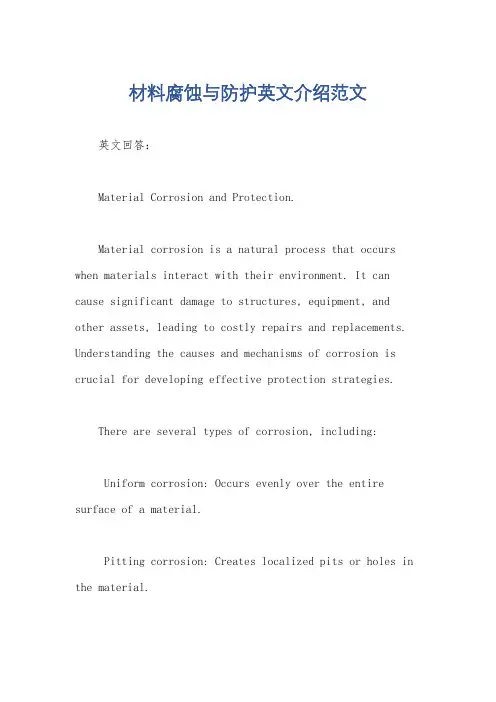
材料腐蚀与防护英文介绍范文英文回答:Material Corrosion and Protection.Material corrosion is a natural process that occurs when materials interact with their environment. It can cause significant damage to structures, equipment, and other assets, leading to costly repairs and replacements. Understanding the causes and mechanisms of corrosion is crucial for developing effective protection strategies.There are several types of corrosion, including:Uniform corrosion: Occurs evenly over the entire surface of a material.Pitting corrosion: Creates localized pits or holes in the material.Crevice corrosion: Occurs in tight spaces or crevices where oxygen and moisture can accumulate.Intergranular corrosion: Attacks the grain boundariesof a material.Stress corrosion cracking: Occurs when a material is subjected to stress and a corrosive environment.The severity of corrosion depends on various factors, such as:The material's composition: Some materials are more resistant to corrosion than others.The environment: Factors such as temperature, humidity, and exposure to chemicals can influence corrosion rates.The presence of protective coatings or treatments: Coatings and treatments can help protect materials from corrosion.Preventing or mitigating corrosion is essential for maintaining the integrity and durability of materials. There are several methods for protecting materials from corrosion, including:Using corrosion-resistant materials: Choosing materials that are naturally resistant to corrosion can help reduce the risk of damage.Applying protective coatings: Coatings, such as paint, epoxy, or zinc, can provide a barrier between the material and the corrosive environment.Using cathodic protection: This technique involves applying a sacrificial anode to the material, which corrodes instead of the material it is protecting.Anodic protection: This technique involves applying a protective oxide layer to the material, which prevents corrosion.Corrosion inhibitors: These chemicals can be added tothe environment to slow down or prevent corrosion.By understanding the mechanisms of corrosion and implementing appropriate protection measures, it is possible to minimize the damage caused by this natural process.中文回答:材料腐蚀与防护。